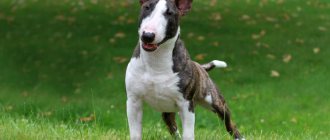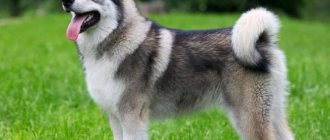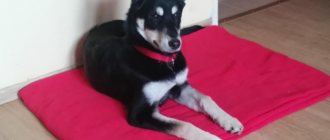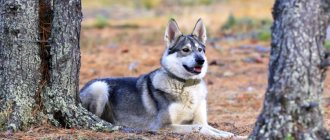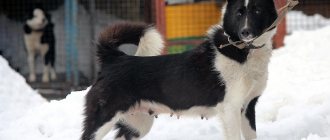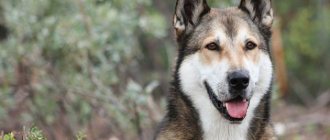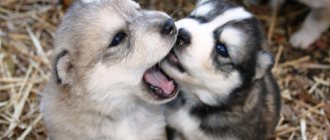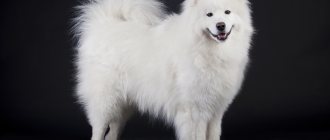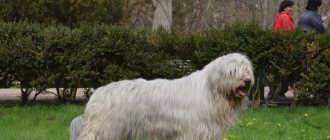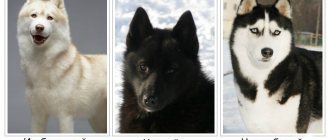Many people who are not very well versed in dog breeding confuse huskies and huskies and do not know what the difference is between them.
Indeed, there are many similarities between these two breeds, however, they have no less differences.
Moreover, this applies not only to the exterior, but also to the characteristics of the psyche, character, temperament and even purpose.
All this must be taken into account when keeping, raising and training these dogs, and therefore, anyone who is thinking about purchasing a husky or husky needs to study the similarities and differences of these two dogs before purchasing a puppy.
This will not only help provide the pet with the most suitable living conditions, but will also save their owners from disappointment in the future.
Brief information about Husky
Photo and description
The dog is of medium height (approximately from 50 to 60 cm at the withers, weight is about 15-28 kg), compact, but at the same time harmonious build.
The body is slightly stretched and exceeds the height at the withers by no more than 2-3 cm; the shape of the head from above resembles a triangle, slightly tapering towards the muzzle. The stop is well defined, but not sharp.
The length of the muzzle is approximately equal to the length of the cranial part of the head.
The ears are erect, triangular, of medium size, set quite close to each other.
The eyes are almond-shaped, slightly slanted. Their color can be blue, brown, amber, olive. In addition, different eye colors .
IMPORTANT!
The nose, as well as the pigmentation of the lips and rims of the eyelids, depending on the color, can be black or brownish.
The neck is of medium length, the chest is deep and powerful, but not too voluminous. The forelimbs are moderately wide, even and parallel. The hind legs are muscular, with well-defined angulations of the hock joints. The tail is similar to a fox's, in a calm state it is lowered downwards, but when alert, it is carried in the form of a sickle over the back.
The coat is not too long, two-layered, while the undercoat is thick and soft, and the coarser hair is quite smooth and adjacent to the body. The color can be almost any, although the most typical colors for huskies are grey-white, black-and-white, brown-white and reddish-white.
Advantages and disadvantages
Pros:
- Intelligence and intelligence.
- Ability to make decisions independently when necessary.
- Lack of aggression towards humans.
- Love for children and playful disposition.
- Loyalty to the owner.
- Endurance and unpretentiousness.
- Easy hair care.
- They make excellent sled or sport dogs.
Minuses:
- Not suitable as guard dogs.
- Tendency to dig up the earth.
- Sometimes they are headstrong and stubborn.
- They often howl.
- They can be aggressive towards smaller animals.
- They need a lot of physical activity and long walks.
- Out of boredom, they can start to damage things in the house.
Character
Lively and friendly towards people. Huskies, unless serious mistakes were made during their upbringing , are never aggressive towards humans and are not inclined to bite.
Friendliness towards strangers and lack of territorial instinct make these dogs poor guards and this must be taken into account by people thinking about purchasing such a pet.
Huskies have an innate hunting instinct, but they will not make hunters either. These dogs hunt for game only for their own food and will never give it up to their owner of their own free will.
These are independent, independent, and sometimes stubborn and willful animals, prone to running away and wandering.
In addition, huskies love to dig up the ground and, out of boredom, can chew furniture, tear off wallpaper, or howl like wolves.
However, when keeping these dogs in the house, you need to take into account that most of the bad habits of a husky are easy to remove or simply prevent them from appearing in your pet. This is achieved through early socialization and proper education and training.
In addition, as noted above, huskies act out mainly from boredom and idleness, and therefore, if you provide the dog with sufficient mental and physical stress, it simply will not have time for mischief.
A little about likes
Photo and description
Laikas are not representatives of one breed, but a breed group that unites several dogs similar in origin, appearance and purpose.
Most huskies are hunting dogs, although many are also suitable for other work. For example, the Nenets Laika is excellent at herding deer, and the Yakut Laika can be used not only for hunting, but also as a sled dog.
In terms of their physique and coat characteristics, huskies are very close to dogs of the so-called wild or wolf type. Moreover, representatives of different breeds of huskies differ from each other, first of all, in the structure of the head and muzzle.
All of them are characterized by a strong, but not squat, build, as well as pointed, erect ears and a tail curled into a full or incomplete ring.
The coat of these dogs is not too long, but at the same time very dense and thick, with an abundant, moderately soft undercoat.
Laikas can come in a variety of colors, but the most typical coat colors are wolf, gray or black, often accompanied by white markings of various shapes and sizes.
Advantages and disadvantages
Pros:
- Excellent hunting dogs, suitable for tracking a variety of game.
- Hardy and unpretentious.
- They are distinguished by good health and, often, long life expectancy.
- Balanced and calm character.
- Devotion and obedience.
- Goodwill towards people, which, however, does not prevent huskies from being good guards.
- Undemanding to nutrition.
Minuses:
- Not suitable for keeping in an apartment.
- Hunting huskies may be at risk of contracting a serious infection in the forest or field.
- Very strong shedding.
- Despite their devotion, they can become disobedient when chasing game.
Character
Laika is quite independent and proud; she recognizes only partnerships with her owner and does not tolerate either excessive familiarity or rudeness in handling herself. This is a very smart and quick-witted animal, which, depending on the current situation, can make its own decisions during the hunt.
Laikas are friendly towards people and make good companions for children, especially since most of these dogs have a cheerful and playful disposition. Laikas are distrustful of strangers, but without increased aggression.
NOTE!
These dogs have an innate viciousness and ruthlessness towards prey, therefore, huskies need early socialization, without which they can be dangerous to pets smaller than themselves.
Maintenance and care
The Yakut Laika is not well adapted to urban realities, much less to life in an apartment. The natural environment for a dog is a country estate with a large walking area or an ordinary rural farmstead. Having a thick coat, animals tolerate cold weather more easily than tropical heat, so it is not advisable to take them out for walks and hunting on especially hot days. The optimal living conditions for “Yakuts” are a yard and an enclosure. Keeping a husky in the house is also possible, but it involves a number of inconveniences for both the pet and the owner.
Hygiene
It is clear that Siberian hunters had no time to deal with the image of working dogs, so today’s Yakut huskies are undemanding in terms of care, and they do not necessarily need to be taken to grooming salons. The breed sheds seasonally, and the hair of huskies does not emit a strong dog smell. In principle, it is not advisable to bathe “northerners”, since their “fur coats” are capable of self-cleaning, but it is necessary to give your pet a bath a couple of times a year. You will have to tinker more with exhibition specimens, and in this case, costs for professional cosmetics cannot be avoided. Particular attention will have to be paid to white huskies - they need shampoos and conditioners designed specifically for “blond” dogs.
A washed Yakut Laika can be dried with a hairdryer or compressor - the hair structure does not suffer from this. During the shedding period, the dog will have to be brushed daily to prevent the loose undercoat from matting. The rest of the time, you can brush your pet sporadically – once a week or less.
Even a child can master eye care for the Yakut Laika. It is enough to moisten a clean cloth in hygienic ophthalmic lotion or strong tea infusion and wipe the edges of the eyelids, removing dust and mucous lumps from them. Ear cleaning is carried out once a week according to the same principle: we buy lotion for the hygiene of the ear funnel and use a clean cloth to remove excess wax. Nail trimming is mandatory for huskies that walk little and unproductively; claws need to be shortened with a nail clipper for medium-sized breeds about once a month.
Feeding
The ancestors of the Yakut huskies were not spoiled with pickles - in winter the dog was fed dried fish so that it had the strength to pull the sled, and in the summer, during a period of relative inactivity, they were treated to slops and leftovers. Today there is no point in following northern traditions, so most breeders feed their pupils either high-quality “dried” or natural products. At the same time, the “seasonality” of the diet should be observed if the animal lives in a yard or enclosure: in winter, feed more densely (80% of the diet is meat protein), in summer - less calorie.
The diet of modern Yakut huskies is raw or lightly cooked lean meat (rabbit, chicken, lamb, horse meat, turkey), tripe, any offal, sea fish with bones previously removed, cereal porridge cooked in bone or meat broth. Not all dogs digest fermented milk products, so they can only be given to dogs for whom this food does not cause digestive upset. Vegetables and fruits, except potatoes and legumes, are only beneficial for huskies. Moreover, they should be given dried or raw - cut into thin slices, as well as shaved. Cabbage and other cruciferous vegetables are best served boiled.
Chicken egg yolk, unrefined vegetable oil, fish oil, kelp, tendons and spongy flat bones are fortified supplements to the basic diet, without which the puppy’s development will slow down. You should also not refuse to buy pharmaceutical dietary supplements with chondroitin and glucosamine, but only if the dog has a natural menu. Some hunters advise lightly adding salt to dog food, but this matter must be approached with extreme caution. It is also useful to arrange fasting days 3-4 times a month, when the husky drinks only water and eats a small amount of rye crackers. The rest of the time, an adult dog is fed twice a day, puppies under one year of age - 4-5 times.
Main differences
The main characteristics by which huskies and huskies differ:
- Huskies have a denser and more muscular build, while huskies are taller and have lighter bones.
- Huskies' ears are rounded at the ends, while huskies' ears are pointed.
- Husky paws are wider, stronger and more powerful than those of huskies.
- Laikas have rounder eyes, while Huskies have almond-shaped eyes. In addition, the eye color of a husky can only be dark, and not blue or heterochromic, like that of a husky.
- The look of a husky expresses curiosity and energy, while the look of huskies shows balance, attentiveness and some wariness.
- The fur of huskies is coarser in texture than that of huskies.
- The husky's tail is held downwards or in the shape of a sickle, while in huskies it is curled into a complete or incomplete ring.
- Huskies are larger in size: their height reaches 60 cm and their weight is 28 kg, while huskies are smaller and weigh more than 23 kg.
Huskies are larger and heavier than huskies, they have stronger bones and better developed muscles. Laikas look taller and lighter-boned compared to them.
Husky ears are rounded at the ends, while husky ears are sharper, and eyes can be not only brown, but also blue and even different colors. Laikas can be exceptionally dark-eyed, and their gaze is calmer and more serious than that of a husky.
The main external difference between the husky and the husky is that the husky’s tail is wrapped in a ring, while the husky’s tail resembles a fox’s and hangs down when at rest.
Common features
The main external similarity of these dogs is their erect ears, as well as a wedge-shaped head and a slightly pointed muzzle.
The coat of a husky and a husky also has a similar structure - it is very dense and dense, consisting of a soft undercoat and a coarser and tougher awn.
Both huskies and huskies look like strong and hardy animals, and they also both have some external resemblance to wolves.
brief information
For some reason, the general public has an opinion that huskies and huskies are representatives of the same breed. But in fact, these dogs have big differences in appearance and especially in temperament. It is only at first glance that there is a lot in common between the husky and the husky, most often in appearance: they are both of medium size, short-haired, with an elongated muzzle and erect ears, and their main difference from other breeds is the tail curled into a ring.
Recently, huskies have become very popular among residents of large cities. They captivated people with their beauty, or rather, the charm of their blue eyes. Laikas were popular a little earlier, but inexperienced animal lovers kept these restless and cheerful dogs in apartments and thereby doomed themselves and their pets to great inconvenience and discomfort.
So, before purchasing one or another breed of dog, you should carefully study all the character traits and necessary conditions for the life of the animal.
Who is easier to maintain and care for?
Despite the popular belief that Huskies are not easy to keep indoors, caring for these dogs is not difficult. Representatives of this breed require infrequent brushing, occasional bathing as needed, and eye, ear, and nail care. Only during shedding do they need to be brushed daily.
In huskies, shedding is more pronounced than even in huskies, which makes caring for them somewhat more difficult. In addition, these dogs' fur has a coarser texture, making it more difficult to remove from clothing, carpets and upholstered furniture.
IMPORTANT!
When caring for and maintaining hunting huskies, you should never neglect treating your pet for parasites and timely vaccinations, since these dogs are prone to infectious diseases transmitted from other animals or carried by external parasites.
Differences in care and education
There is an opinion that huskies should not be kept in an apartment. In fact, caring for them is easy. Enough brushing during shedding - it happens twice a year. This breed is perfect for active sporting owners. She can accompany them everywhere.
Caring for a husky is more difficult. She has a shiny and smooth coat. If you do not brush it regularly, your pet will begin to suffer from skin ailments. Water procedures are carried out, if necessary, using standard laundry soap. If the dog is hungry, he will hunt in the forest. It is better not to keep him in the apartment, but if there is no choice, you will have to walk with them for at least two hours. You should let the leash go outside.
Video: how is a husky different from a husky?
Attitude towards children and pets
Both huskies and many huskies have a cheerful and playful disposition and are good with children.
However, some breeds of huskies are not recommended as pets for families with children, as their nature is too stern and independent for these dogs to calmly deal with children who bother them or tease them.
As for the attitude of these dogs towards other domestic animals, huskies, who do not have innate malice towards the beast, are more tolerant of them than huskies.
Who is more picky about feeding?
Both dogs can eat both home-cooked and commercially prepared food and are not particularly picky about what they feed.
However, you need to take into account that huskies are more prone to overeating, and therefore it is necessary to take a more responsible approach to their diet and not supplement the pet between feedings.
Comparison by other criteria
Aggression towards people
Uncharacteristic of either huskies or huskies.
But at the same time, the latter can treat strangers with distrust and can even be good guards, while huskies are friendly towards all people and because of this are completely unsuitable for protection.
Activity and exercise
Both dogs require a lot of exercise and are energetic and active. There are almost no differences in this matter.
Lifespan
The difference here is that huskies live on average 12-14 years, while the life expectancy of huskies can reach 17 years.
Nutrition
The main difference in feeding huskies and huskies is that huskies can eat fattier foods. And this can cause huskies to have digestive problems. Huskies are recommended to be fed before exercise and before walks, and not after.
It is also not recommended to use a mixed type of diet to avoid diseases of the digestive tract. That is, you need to use either dry food or natural products.
The diet of huskies and huskies on natural food should contain the following products:
- beef;
- venison;
- turkey;
- lean pork;
- chicken;
- low-fat sea fish (once a week);
- cartilage;
- porridge;
- cottage cheese;
- vegetables.
Note! Bones are recommended only for chewing, not for ingestion.
Price difference
The cost of husky puppies with documents starts from 15 thousand.
A small husky can be purchased for 5-10 thousand, however, if we are talking about purchasing a dog from parents who have shown excellent results in hunting, then its cost may be slightly higher.
Who should you choose?
When choosing who to buy, you must, first of all, proceed from the purpose of the future pet. If you need a hunting dog, then you need to buy a husky, but if you need a dog for sledding, then you should buy a husky.
Conditions of detention are also of great importance. Laikas are not suitable for living in an apartment, while huskies tolerate indoor living quite well, provided they receive sufficient physical and mental exercise.
NOTE!
For families with small children, a husky is better suited, since not all huskies can be kind to kids, but at the same time they will make wonderful friends for older children.
Similar in appearance, but different in character
The following differences are observed in the nature of the breeds:
- Huskies are considered one of the most resilient. They can pull a team all day without a break. This happens because they are able to control their own metabolism. They do not help humans in hunting, obtaining food for themselves. Laikas are not so hardy, they are irreplaceable for hunters. That is, the instincts of the breeds are equally good, but the goal is different.
- Huskies are reserved and hardly bark. If they need to show emotion, they howl. In this they are more like wolves than other dogs. Likes are very loud, which justifies their name.
- The Husky's attitude towards people is good-natured and there is no aggressiveness at all. This explains the inability to protect. Likes are better guards because they are selective in their own emotions.
- Training for hunters is easier than for Siberians. The latter need to prove that the boss in the house is the owner. After this, they just start training.
The attachment of huskies to the owner is strong, but the instinct of the hunter sometimes outweighs it. The pet may suddenly go hunting with another dog without permission. It is also important for him to prove the superiority of the owner, trying not to hurt his pride. The dog does not like strangers in his own area, even if it is a child or an animal. It is important for him to get used to contact with pets, otherwise he will begin to view them as prey. The breed is not suitable for living in an apartment or on a leash. The Russian-European type is an exception. Their character and compact size allows them to do this.
Huskies feel fine in an apartment and tolerate change well. But the chain is also contraindicated for them, because they cannot be used as a security guard. If the dog has to sit still, it will howl in anguish. She requires physical activity, so when living on the street, it is important to provide it by walking for a long time with the pet.
Huskies are not aggressive with other dogs, especially if there were no deviations in their upbringing. But they tend to dominate, so they can start to sort things out. Having a puppy or cat in the house is not a contraindication for a Siberian. He will soon make it clear who is in charge here. The situation is different with an adult relative.
But representatives of the breed are very friendly. When Eskimos had children, they called pets from the street into the house. The animals lay down around the baby to keep him warm.

